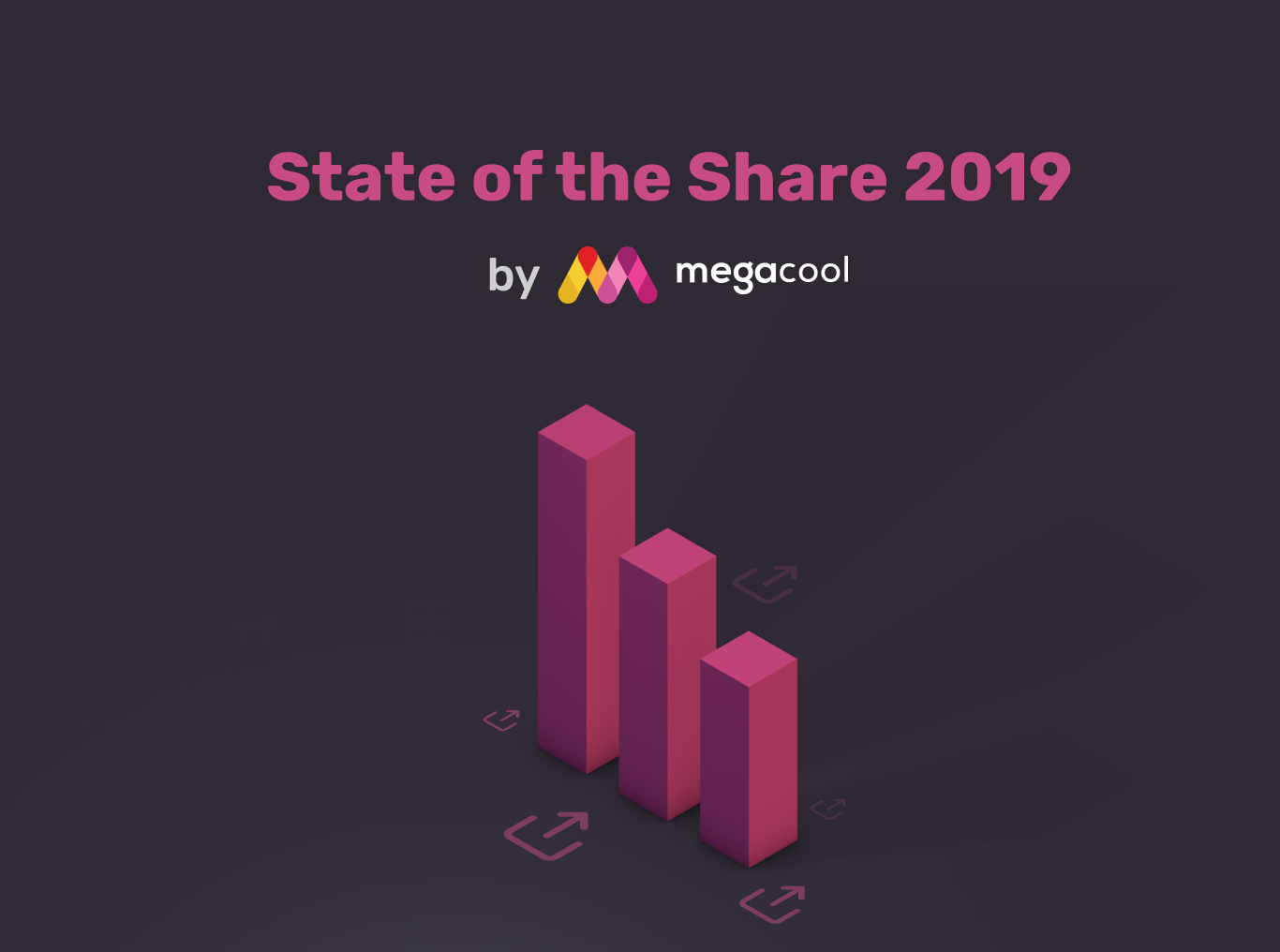From the dawn of time, humans have always had a desire to share our feelings, our stories and our successes. From primitive language to the postal service, sharing is human nature.
Technology has made sharing easier – and it’s become a major part of the playbook for app developers and digital marketers. From tweeting our highscores to challenging friends on Facebook, we share more in 2019 than ever before. In this post, we’ll use the insight we’ve gathered from working with some of the top studios in mobile gaming, and explore the current state of the mobile content sharing experience.
We’ve pulled together data from millions of share events from mobile games, and found some surprising conclusions. Let’s dive right in.
The most popular sharing apps are not what you think
With over 2 billion people using Facebook every month, it’s an easy assumption that the social giant is the most popular destination for players looking to share, right?
Actually, that’s not the case at all: while Facebook is still the king of social networks, it’s no longer the go-to place for players when they want to show off their achievements, high-scores, and gaming fails. In fact, while it sits in second place on Android for shares, it doesn’t even crack the top five on iOS.
On top of that, another major social platform, Twitter, ranks #9 on iOS and doesn’t even make the top 10 on Android.
More and more, players are turning to messaging services to share their favorite gaming moments instead of social media. In 2019, messaging apps are no longer a small rise on the sharing landscape. They are the landscape.

The rise of messaging apps
Messaging apps like WhatsApp or Apple’s own iMessage service are now the most popular destination for players when it comes to sharing. From our data sample, as much as 70% of iOS shares and 54% of Android shares are over direct user-to-user apps vs. social apps.
Messaging apps have become the new way for players to share with friends. And that makes sense! In today’s world, we care more about curating the information that we receive – and the information that we put out there for others.
There’s enormous social strength in getting a personal recommendation from someone you know and trust. Equally, there’s social strength in being the person who made a successful recommendation: you told someone that a game was cool, and they agreed with you.
Players are evolving into micro-influencers. The days of spamming your entire Facebook feed with your latest gaming achievement are being replaced by carefully selecting the audience that you believe to be most relevant.
In addition to Messaging apps, both Mail and Copy to Pasteboard are popular apps to use for sharing on iOS. This indicates a strong interest from players to control where content is being shared and who receives it.
One other noteworthy entry on this list is the surprising popularity of the iOS Reminder app. It’s hard to say exactly what’s driving this behavior, but our hypothesis is that players are storing the content for themselves to review and share later.
Android offers greater app diversity compared to iOS

On iOS we’ve analyzed data from 25 different apps that use the Megacool SDK, but on Android we have an even larger data selection of 155 apps. This can also be seen from how dominant “Other” apps for Android are compared to iOS. There’s much more choice for users.
Why was YouTube and Instagram missing from the iOS overview?
A notable absence on the list of apps people share to on iOS are two popular share targets on Android: YouTube and Instagram. The YouTube app on iOS does for some reason not include the sharing extensions needed to make it possible to share video to it. This might be an oversight by Google, which surely makes it harder than necessary for people to share their moments to YouTube.
When it comes to Instagram they do include a sharing extension with the app that generally makes it possible to share to it, but it puts some restrictions on the type of content shared that prevents it from being possible to share to it from Megacool. More specifically, you can only share a single piece of content to Instagram - the Megacool SDK uses Apple’s recommended approach to sharing complex content, which means we include both text, a url, and the GIF. Instagram should adapt the same approach that most other apps take, which is to filter out ineligible content when the share extension is selected, instead of having overly restrictive filters that prevents the extension from being selected at all.
When it comes to sharing, which apps lead to the most clicks?
If marketing strategy A reaches 1,000 people and marketing strategy B reaches 1, it would be logical to conclude that strategy A is the one to go for. But out of those 1,000, how many actually click on the link? And how many of those lead to a new installation?
Facebook and Facebook-owned apps are dominant when driving clicks. Private messaging apps have lower click rates, but rank highly due to large volumes of shares. When sharing to a private messaging app there is usually only 1 click on a link.
So far we’ve talked a lot about the power of messaging apps, but the graphic below is a great example of the value that Facebook continues to offer to marketers looking to build awareness for their game. Facebook still has the potential for enormous reach. The average Facebook user has over 150 friends, meaning that a single share to Facebook could reach hundreds or even thousands of people, particularly if the shared content is engaging like a video clip or GIF.


Even with those impressive figures for Facebook, though, this still shows that shares via messaging apps also generate a lot of clicks. WhatsApp, Facebook Messenger, Messages and LINE combine for almost 50% of all clicks from our data sample on both iOS and Android.
Messaging apps have lower reach but generate more installs
When you’re trying to grow your game, it’s not necessarily how many people you reach, but whether you reach the right people.
We’ve looked at which platforms have the best reach and generate the most clicks, but at the end of the day we’re all looking for those precious installs.
In our data, messaging apps continue to dominate over social media when it comes to driving installs:


On both Android and iOS, over 80% of installs from content shares are driven through private messaging apps. This suggests that developers will see a growth in organic installs by supporting content sharing to WhatsApp, Messages and Facebook Messenger. This also applies to re-engaging users, as we’ll see later.
VKontakte, the Russian social network, is a high-performer on Android, and is also considered a private messaging app in the analysis because the user can only share the content as a direct message.
Which apps are more effective at driving installs?
In addition to looking at where the install volumes come from, it’s important to look at which apps have the highest conversion rates from shares to installs. We compared each app’s conversion rate with the average conversion rate, and found that once again messaging apps are far more likely to lead to an install.
Even though shares to social networks have the potential to reach high numbers of people, a specifically-targeted share via a messaging app converts at a much higher rate.
The perfect illustration of this is from Facebook’s own Messenger app. Facebook Messenger is 4x more likely to lead to an install than a post to Facebook itself, even though that post is likely to reach many, many more people.


As we’ve already seen, messaging apps make up the majority of shares from the games we looked at, so the numbers above aren’t totally surprising. So, let’s take a look at which apps are best at re-engaging users, in our next section.
And how about re-engagement?
It’s not just new installs that are valuable to app developers. We’re increasingly seeing companies devote more of their marketing budget to reactivating lapsed players in the knowledge that they’re among the most valuable (particularly if they’ve already made an IAP before lapsing).
Most companies focus re-engagement efforts through push notifications, while sharing can also yield a powerful way of having existing players nudging each other with great content and FOMO.
Messaging apps continue to be the top-performers in getting those valuable re-activations, with Facebook posts lagging behind at less than 2% re-engagement.




Once again, this shows the power of curated, specific nature of a personal message over a wider-reaching social media post. In sending a share via a messaging app, a player is selecting a person that they believe has a high chance of being interested in the content.
In this case, it may well be someone whom they know has already played the game before – and that share is what prompts that player to become re-engaged with the game.
What are people sharing, and why?
There are several reasons for why a player would share. Here’s some of the most common we’ve seen:
- To show off/brag about an achievement
- Ask for help
- Referral
- Wanting to play together

As seen across the results above where we look closer at what sharing features the most install-driving have, the most effective sharing experience includes a capture of the experience, a link to facilitate the onboarding of the recipient and some pre-set text to reduce the friction. It’s important that the pre-set text doesn’t sound like a sales pitch.
Looking more closely at what content someone shares, it usually falls in under one of the following:
- When something funny happens
- Almost lost, but made it after all
- When you lost, but it wasn’t your fault
Conclusions
There’s plenty we can draw from this data, not least the power and influence of messaging apps when it comes to growing your game:
- Messaging apps are the most popular to share content with
- Messaging apps drive the most installs
- Messaging apps drive the most re-engagement
- Messaging apps have the highest conversion rate from shares to installs
The massive reach of Facebook is still very strong at generating link clicks, but the personalized nature of choosing a specific person to share to leads to a higher conversion rate on messaging apps.
The fact that so many players are choosing to share to messaging apps over social platforms is something that marketers should pay close attention to. Social media still has massive reach and viral potential, but today’s players are beginning to move away from those platforms in favor of a more personalized experience. They are realizing their role as a micro-influencer within their own social circles, and carefully selecting what they share and who they share it with.
The days of spamming a Facebook feed with trophies, high-scores and requests from a mobile game are beginning to fade away. Sharing via messaging apps may be the future, and are certainly the present.
About the data
We're analyzing anonymous data associated with the capturing and sharing with the Megacool SDK. The Megacool SDK captures the screen during gameplay and let’s the player share the content as a GIF, with a link attached to the share. The link serves as both a place where the receiver can view the GIF if media sharing was not supported for the chosen app, and enables the receiver to download or open the game.
- Data analyzed from using Megacool SDK to share game replays between October 2018 and January 2019.
- We’ve analyzed over 4.5M sharing events on Android and 1.2M on iOS
- The sharing activity can be incentivized as tied to a referral program depending on each individual developer’s implementation of the SDK.
If you’re looking for new tools to support your marketing in 2019, Megacool turns your users into micro-influencers by making it easy to record replays and share these on their preferred social apps. We’d be thrilled to assist.



